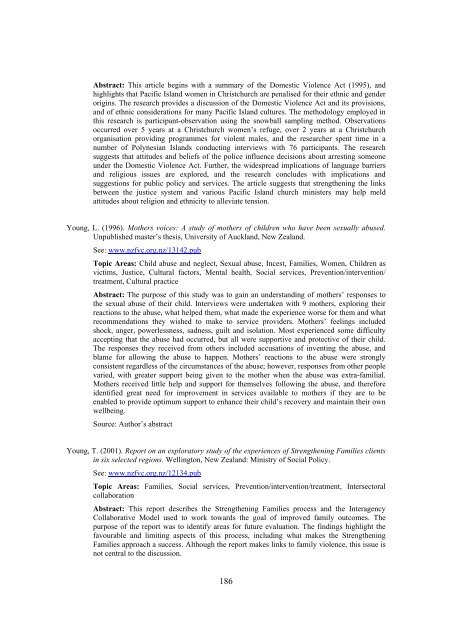annotated bibliography of new zealand research into family violence
annotated bibliography of new zealand research into family violence
annotated bibliography of new zealand research into family violence
Create successful ePaper yourself
Turn your PDF publications into a flip-book with our unique Google optimized e-Paper software.
Abstract: This article begins with a summary <strong>of</strong> the Domestic Violence Act (1995), andhighlights that Pacific Island women in Christchurch are penalised for their ethnic and genderorigins. The <strong>research</strong> provides a discussion <strong>of</strong> the Domestic Violence Act and its provisions,and <strong>of</strong> ethnic considerations for many Pacific Island cultures. The methodology employed inthis <strong>research</strong> is participant-observation using the snowball sampling method. Observationsoccurred over 5 years at a Christchurch women’s refuge, over 2 years at a Christchurchorganisation providing programmes for violent males, and the <strong>research</strong>er spent time in anumber <strong>of</strong> Polynesian Islands conducting interviews with 76 participants. The <strong>research</strong>suggests that attitudes and beliefs <strong>of</strong> the police influence decisions about arresting someoneunder the Domestic Violence Act. Further, the widespread implications <strong>of</strong> language barriersand religious issues are explored, and the <strong>research</strong> concludes with implications andsuggestions for public policy and services. The article suggests that strengthening the linksbetween the justice system and various Pacific Island church ministers may help meldattitudes about religion and ethnicity to alleviate tension.Young, L. (1996). Mothers voices: A study <strong>of</strong> mothers <strong>of</strong> children who have been sexually abused.Unpublished master’s thesis, University <strong>of</strong> Auckland, New Zealand.See: www.nzfvc.org.nz/13142.pubTopic Areas: Child abuse and neglect, Sexual abuse, Incest, Families, Women, Children asvictims, Justice, Cultural factors, Mental health, Social services, Prevention/intervention/treatment, Cultural practiceAbstract: The purpose <strong>of</strong> this study was to gain an understanding <strong>of</strong> mothers’ responses tothe sexual abuse <strong>of</strong> their child. Interviews were undertaken with 9 mothers, exploring theirreactions to the abuse, what helped them, what made the experience worse for them and whatrecommendations they wished to make to service providers. Mothers’ feelings includedshock, anger, powerlessness, sadness, guilt and isolation. Most experienced some difficultyaccepting that the abuse had occurred, but all were supportive and protective <strong>of</strong> their child.The responses they received from others included accusations <strong>of</strong> inventing the abuse, andblame for allowing the abuse to happen. Mothers’ reactions to the abuse were stronglyconsistent regardless <strong>of</strong> the circumstances <strong>of</strong> the abuse; however, responses from other peoplevaried, with greater support being given to the mother when the abuse was extra-familial.Mothers received little help and support for themselves following the abuse, and thereforeidentified great need for improvement in services available to mothers if they are to beenabled to provide optimum support to enhance their child’s recovery and maintain their ownwellbeing.Source: Author’s abstractYoung, T. (2001). Report on an exploratory study <strong>of</strong> the experiences <strong>of</strong> Strengthening Families clientsin six selected regions. Wellington, New Zealand: Ministry <strong>of</strong> Social Policy.See: www.nzfvc.org.nz/12134.pubTopic Areas: Families, Social services, Prevention/intervention/treatment, IntersectoralcollaborationAbstract: This report describes the Strengthening Families process and the InteragencyCollaborative Model used to work towards the goal <strong>of</strong> improved <strong>family</strong> outcomes. Thepurpose <strong>of</strong> the report was to identify areas for future evaluation. The findings highlight thefavourable and limiting aspects <strong>of</strong> this process, including what makes the StrengtheningFamilies approach a success. Although the report makes links to <strong>family</strong> <strong>violence</strong>, this issue isnot central to the discussion.186












